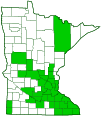great golden digger wasp
(Sphex ichneumoneus)
Conservation • Description • Habitat • Ecology • Distribution • Taxonomy
Conservation Status |
|
|||||||
| IUCN Red List | not listed |
|||||||
| NatureServe | not listed |
|||||||
| Minnesota | not listed |
|||||||
Description |
||
Great golden digger wasp is a widespread, fairly common, large, thread-waisted wasp. It occurs across the United States, in adjacent Canadian provinces, in Central America, and in South America. In Minnesota it is common in the southeast and metro areas, absent in the north. Although common, it is wary and seldom seen. Females are slender and ⅞″ to 1 1 ⁄16″ (23 to 27 mm) long. The head is black and is covered with abundant erect golden hairs. There are two large compound eyes, one on each side of the head; and three small simple eyes (ocelli) in a triangular pattern at the top of the head between the compound eyes. The face and the area behind each compound eye (postocular area) have appressed golden hairs. The antennae are thread-like, are not elbowed, and are black except for the underside of the basal segment, which is reddish-orange. The mandibles are reddish-orange at the base, black at the tip. The thorax (mesosoma) is black and has three segments. However, the first segment of the abdomen is fused to the thorax, giving the thorax the appearance of having four segments. The upper plate on the first segment (pronotum) is short and collar-like. There is a short, rounded lobe on each side of the pronotum that does not reach the plate at the base of the wings (tegula). The lobes and the ridge on the pronotum are covered with appressed golden hairs. The tegula is reddish-orange and is also covered with appressed golden hairs. The second segment of the thorax (scutum), by far the largest, is black with pale rear and lateral margins. The abdomen consists of a large first segment (propodeum) that is fused to the thorax; a narrow waist-like second segment (petiole); and the bulbous remainder (gaster). The first two segments of the gaster and the base of the third segment are reddish-orange. The remainder of the gaster is black. The wings are large and amber. When at rest they are folded over the body. They make a rustling noise in flight. In the lower part of the forewing there are two recurrent (backward-turning) veins, both of which meet the second submarginal cell. On the hindwing the discoidal vein rises distinctly beyond the end of the transverse median vein. On each leg, the basal segment (coxa) is reddish-orange. The small second segment (trochanter) may be black, a little reddish-orange, or entirely reddish-orange. The second segment (tibia), third segment (femur), and the end section corresponding to the foot (tarsus) are reddish-orange. Males are smaller than females, averaging ¾″ (19 mm) long, and have less abundant golden hairs. The trochanter and the base of the femur are black. |
||
Size |
||
Male: ¾″ (19 mm) Female: ⅞″ to 1 1 ⁄16″ (23 to 27 mm) |
||
Similar Species |
||
Habitat |
||
Fields, meadows, and gardens near a sandy area |
||
Ecology |
||
Season |
||
One generation per year: June to October |
||
Behavior |
||
Adults are wary, not aggressive, but they may sting if handled. |
||
Life Cycle |
||
|
||
Larva Food |
||
Paralyzed grasshoppers, crickets, and katydids |
||
Adult Food |
||
Flower nectar and plant sap |
||
Distribution |
||||
|
Sources |
|||
| 8/5/2022 | ||||
Occurrence |
||||
Widespread and fairly common |
||||
Taxonomy |
|||
Order |
Hymenoptera (ants, bees, wasps, and sawflies) | ||
Suborder |
Apocrita (narrow-waisted wasps, ants, and bees) | ||
Infraorder |
Aculeata (ants, bees, and stinging wasps) | ||
Superfamily |
Apoidea (bees and apoid wasps) | ||
Family |
Sphecidae (thread-waisted wasps) | ||
Subfamily |
Sphecinae | ||
| Tribe | Sphecini | ||
Genus |
Sphex | ||
| Subgenus | Sphex | ||
Synonyms |
|||
Ammobia auriflua Ammobia ichneumonea Apis ichneumonea Chlorion ichneumoneum Chlorion ichneumoneum aurifluum Nomada surinamensis Proterosphex ichneumoneus Sceliphron aurifluus Sphex aurifluus Sphex aurocapillus Sphex croesus Sphex dimidiatus Sphex ichneumoneus aurifluus Sphex ichneumoneus ignotus Sphex ichneumoneus sumptuosus Sphex sumptuosus |
|||
Common Names |
|||
great golden digger wasp great golden sand digger |
|||
Glossary
Femur
On insects and arachnids, the third, largest, most robust segment of the leg, coming immediately before the tibia. On humans, the thigh bone.
Gaster
The bulbous part of the abdomen of ants, bees, and wasps. In ants it usually begins at segment three.
Mesosoma
In Hymenoptera: the front part of the body, consisting of all three segments of the thorax and the first segment of the abdomen, to which the wings are attached.
Ocellus
Simple eye; an eye with a single lens. Plural: ocelli.
Pronotum
The exoskeletal plate on the upper side of the first segment of the thorax of an insect.
Scape
In plants: An erect, leafless stalk growing from the rootstock and supporting a flower or a flower cluster. In insects: The basal segment of the antenna.
Tarsus
On insects, the last two to five subdivisions of the leg, attached to the tibia; the foot. On spiders, the last segment of the leg. Plural: tarsi.
Tegula
A small, hardened, plate, scale, or flap-like structure that overlaps the base of the forewing of insects in the orders Lepidoptera, Hymenoptera, Diptera, and Homoptera. Plural: tegulae.
Tibia
The fourth segment of an insect leg, after the femur and before the tarsus (foot). The fifth segment of a spider leg or palp. Plural: tibiae.
Visitor Photos |
|||||
Share your photo of this insect. |
|||||
| This button not working for you? Simply email us at info@MinnesotaSeasons.com. Attach one or more photos and, if you like, a caption. |
|||||
Alfredo Colon |
|||||
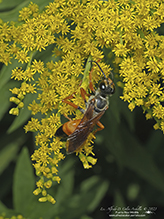 |
|||||
Mike Poeppe |
|||||
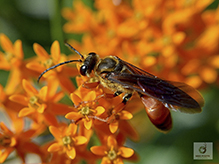 |
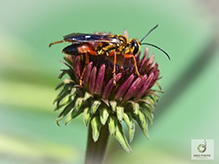 |
||||
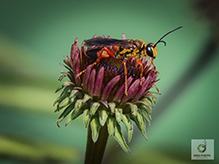 |
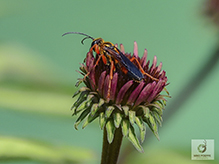 |
||||
Kristyne Holbrook |
|||||
Found in Bridgton, Maine |
|||||
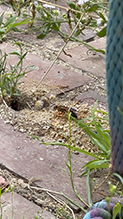 |
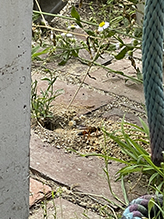 |
||||
Norm & Peg Dibble |
|||||
On 08/3/2019 there were several types of bees or wasps on our large bush of Swamp Milkweed. This black and orange wasp was unfamiliar to me. I usually just see common looking small bees and large black wasps and ants on this bush. |
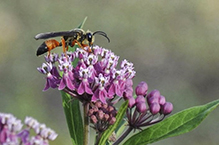 |
||||
MinnesotaSeasons.com Photos |
|||||
|
|||||

Slideshows |
||

Visitor Videos |
|||
Share your video of this mammal. |
|||
| This button not working for you? Simply email us at info@MinnesotaSeasons.com. Attach a video, a YouTube link, or a cloud storage link. |
|||
LMG |
|||
| great black digger wasp 01 Aug 5, 2022 |
|||
About
great black digger wasp (Sphex pensylvanicus) and great golden digger wasp (Sphex ichneumoneus) I managed to get a grey short video showing both black and golden digger wasps feasting on my ornamental alliums. Right on my entryway path… they are harmless but sure don’t look that way and are quite effective at keeping the solicitors away! Southern Scott County, MN. 8/4/2022 Video by LMG http://www.minnesotaseasons.com/Insects/great_black_digger_wasp.html http://www.minnesotaseasons.com/Insects/great_golden_digger_wasp.html |
|||
Other Videos |
|||
| Great Golden Digger Wasp (Sphecidae: Sphex ichneumoneus) Grooming Carl Barrentine |
|||
About
Published on Sep 13, 2009 Photographed at the Kellys Slough NWR, North Dakota (13 September 2009). Go here to learn more about this species: http://bugguide.net/node/view/414 |
|||
| Sphex ichneumoneus getyourbugon |
|||
About
Published on Aug 11, 2012 Sphex ichneumoneus | Great Golden Digger Wasp |
|||
| Great Golden Digger Wasp (Sphecidae: Sphex ichneumoneus) Female Carl Barrentine |
|||
About
Published on Aug 27, 2011 Photographed at the Turtle River State Park, North Dakota (27 August 2011). |
|||


Created: 8/25/2019
Last Updated:
